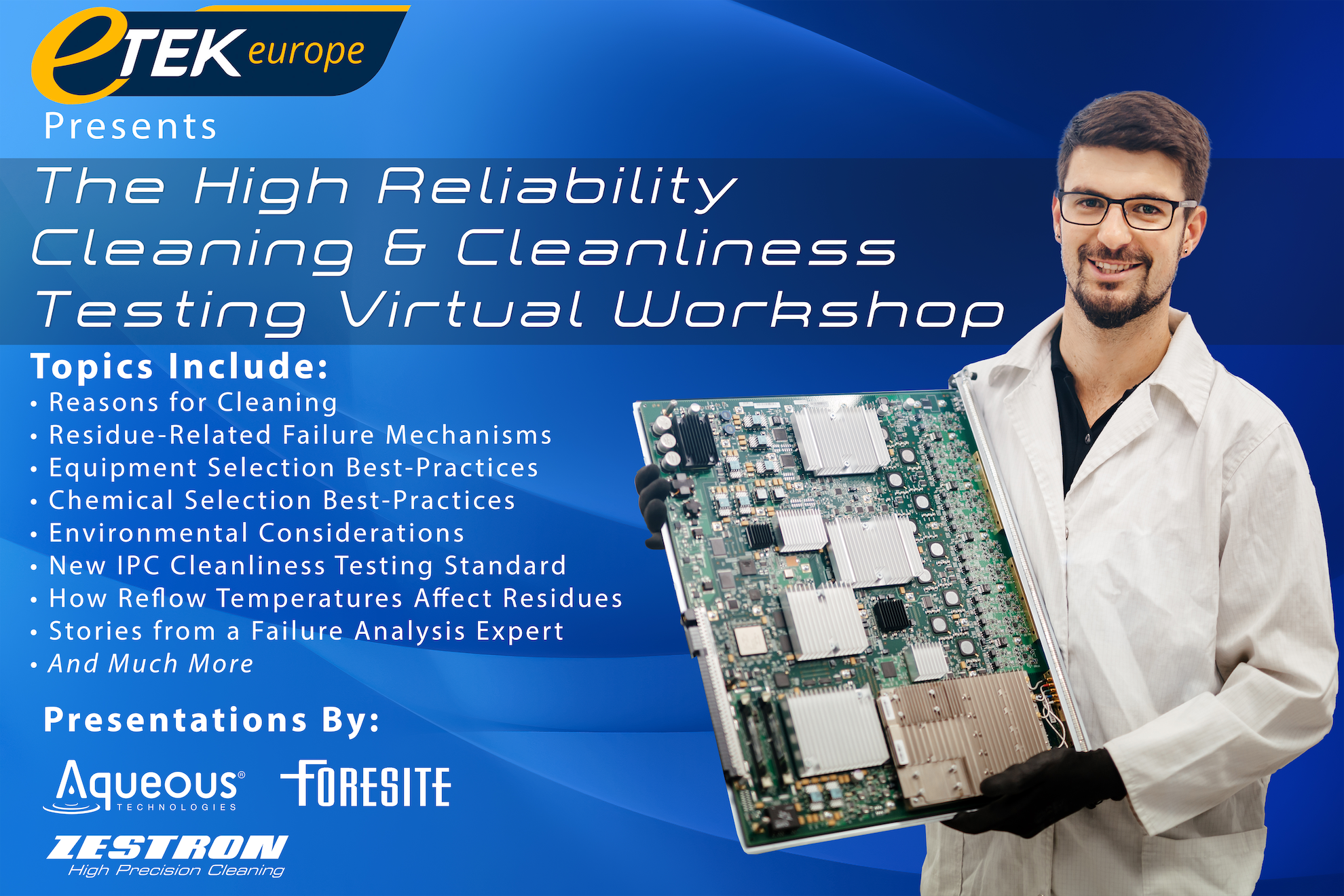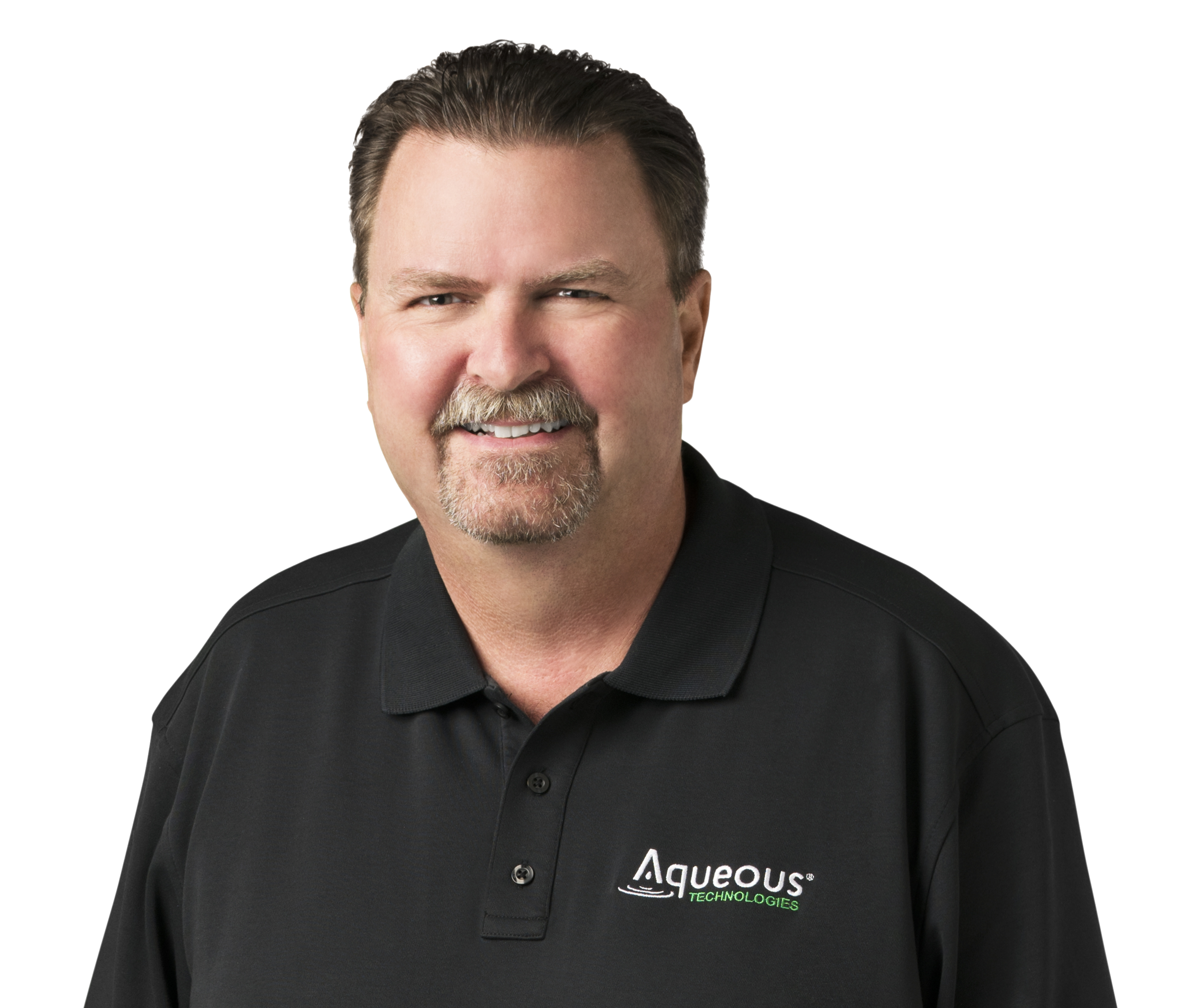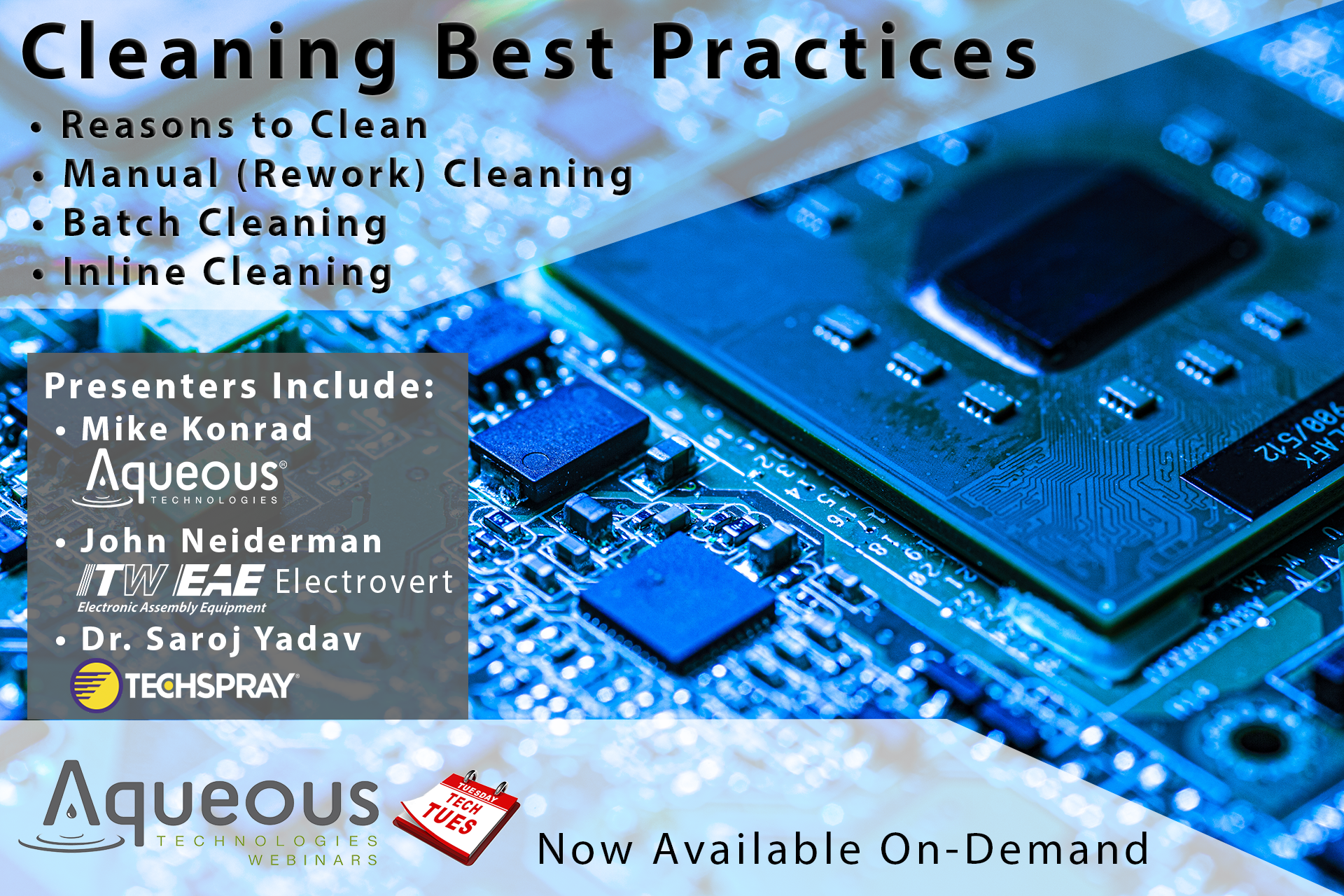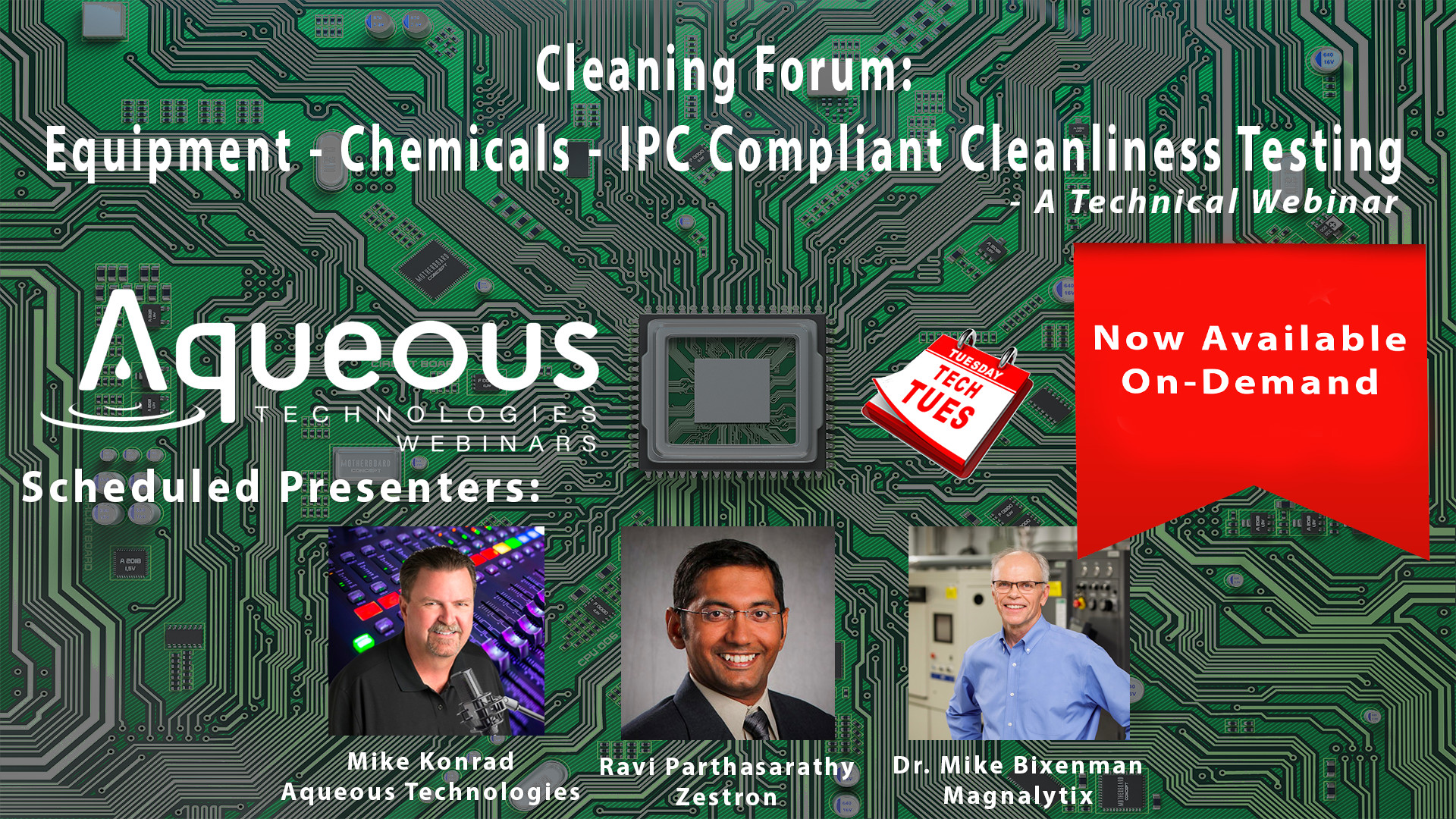Now Available On-Demand
Localized Harsh Environments and ECM: Design-Created Micro-Climates - The Hidden Threat Within Electronic Devices
Poor thermal management can lead to condensation and moisture accumulation on a PCB’s surface, triggering electrochemical migration (ECM) and other reliability failures.
Through real-world case studies, including a billion-dollar recall of a popular video game console due to ECM failures, this webinar will illustrate how improper heat dissipation can create failure-prone conditions, even in devices designed for controlled environments.
By examining design strategies that mitigate localized harsh conditions, this webinar will emphasize the importance of holistic thermal management and an effective cleaning strategy in safeguarding reliability.
Engineers and designers must not only consider external climatic factors but also ensure that the device itself does not become its own worst enemy.
This on-demand non-commercial webinar is presented free of charge.
Webinar Duration: 55 minutes
Now Available On Demand
Impact of Harsh Environments and Ionic Contamination on Circuit Assemblies
There is well documented historical proof that post-reflow circuit assemblies, when subjected to harsh environments, are particularly vulnerable to failure mechanisms that can drastically reduce their performance and longevity. Modern electronic assemblies are far more susceptible to this phenomenon. Among the critical issues affecting these assemblies is ionic contamination, which can lead to a series of deleterious processes, including electrochemical migration (ECM).
This webinar explores the relationship between harsh environmental conditions, ionic contamination, and the resulting electrochemical effects on circuit assemblies.
Webinar Length: 39 Minutes
Cost: This non-commercial webinar is free for all attendees
Now Available On Demand
The Dirty Dozen - 12 Common Mistakes Made When Cleaning Circuit Assemblies
The Dirty Dozen - Twelve Common Mistakes Made When Cleaning Circuit Assemblies is now available to view on demand.
Post-reflow contamination removal of circuit assemblies is a proven method of eliminating electrical chemical migration (ECM) failures. The suggestion that some cleaning is better than no cleaning is grossly inaccurate. The fact is, to eliminate any chance of ECM related failures, cleaning must be performed thoroughly and correctly.
Join us for this informative webinar where we will review the dirty dozen, twelve common mistakes made when cleaning circuit assemblies. Modern cleaning is a go-big or go-home proposition. Circuit assemblies gain added reliability when a cleaning process is performed properly. When a cleaning process is performed improperly, reliability may be substantially worsened.
This webinar is presented free of charge.
You can view this webinar from your computer, tablet or mobile phone's browser. No downloads are required.
Webinar Length: 60 minutes
Now Available On Demand
Step into the intricate world where technology meets resilience, where the reliability of circuit assemblies in the face of unforgiving environments takes center stage. Welcome to a world where the impact of post-reflow contamination on circuit assemblies deployed in harsh conditions is a current reality.
In this MasterClass, we embark on a journey through the intricate web of challenges posed by residues and contaminants, unraveling their detrimental effects on tolerance levels and overall reliability.
As electronic devices solidify their place as indispensable tools across industries, the quest for robust circuit assemblies capable of withstanding harsh environments becomes imperative. This two-hour exploration delves deep into the heart of this challenge, shedding light on the nuances of mitigating contamination. From the selection of cleaning methods to the strategic acquisition of equipment, every aspect is examined. Operational costs, the economics of clean assemblies, operator proficiency, throughput optimization, and the imperative of environmental considerations form the tapestry of our discourse.
Through a comprehensive lens, we navigate the relationship between harsh environments, post-reflow contamination, and the reliability of circuit assemblies. Armed with insights gleaned from this MasterClass, industry professionals will emerge equipped to make informed decisions that resonate with environmental sustainability, budgetary prudence, and operational efficacy.
Furthermore, as the landscape of industry standards evolves, we will review the new IPC cleanliness testing and process monitoring requirements, ensuring that participants are not only abreast of current practices but poised to embrace future advancements.
Join us on this illuminating journey where knowledge intertwines with practice. A Certificate of Completion Will be provided to all those complete this educational journey, underscoring their commitment to excellence in the realm of circuit assembly reliability.
Webinar Length: 100 minutes
Now Available On-Demand
IPC J-STD001-H is now active. Beginning with an amendment to revision "G", major changes were made to post-reflow cleanliness testing requirements. Gone are the old cleanliness pass/fail limits. IPC now requires cleanliness testing based on an objective evidence standard and process monitoring based on ionic contamination testing.
This webinar will review the requirements of the new standard including step-by-step guidance using hypothetical examples based on IPC'S WP-019B whitepaper.
Webinar Length: 53 Minutes
Cost: This non-commercial webinar is offered free of charge
Now Available On-Demand
SMT WARS- Lessons Learned by a Contract Manufacturer and Their Customer Who Sued Them
Aqueous Technologies is proud to announce the return of SMT WARS - Lessons Learned by a Contract Manufacturer and Their Customer who Sued Them.
What happened when an electronic contract manufacturer followed their customer’s instructions to the detriment of the product? Product failures, blame, drama, and a really big lawsuit.
Mike Konrad, who was appointed as an Expert Witness in this civil litigation matter, will present this webinar and review the trials and tribulations of a contract manufacturer and their customer. Assembly residue-related failures (ECM) contributed to product failures, product recalls, and, ultimately, a multi-million-dollar lawsuit.
Misguided “best practice” techniques only made matters worse. This presentation will discuss what factors contributed to the “perfect storm” of product failures. Factors that go as far back to original product designs, printed circuit board fabrication, storage and handling, assembly, testing, and coating. While mistakes were made all along the way, product failures could have been avoided with a few simple process changes, adding mere pennies to the cost of each assembly while saving hundreds of thousands of dollars in litigation.
Webinar Length: 62 Minutes
Now Available On-Demand
The Dirty Dozen - 12 Common Mistakes Made When Cleaning Circuit Assemblies
The Dirty Dozen - Twelve Common Mistakes Made When Cleaning Circuit Assemblies is now available on-demand.
Post-reflow contamination removal of circuit assemblies is a proven method of eliminating electrical chemical migration (ECM) failures. The suggestion that some cleaning is better than no cleaning is grossly inaccurate. The fact is, to eliminate any chance of ECM related failures, cleaning must be performed thoroughly and correctly.
Join us for this informative webinar where we will review the dirty dozen, twelve common mistakes made when cleaning circuit assemblies. Modern cleaning is a go-big or go-home proposition. Circuit assemblies gain added reliability when a cleaning process is performed properly. When a cleaning process is performed improperly, reliability may be substantially worsened.
This webinar is presented free of charge.
Webinar Length: 70 Minutes
Now Available On-Demand:
ABOUT THIS EVENT:
ABOUT THIS WEBINAR:
Our Tech-Tuesday webinar series continue with "Optimizing Your Cleaning Process for Maximum Results at Minimum Cost".
Many modern circuit assemblies now require a cleaning process to operate reliably in their intended climatic operating environment. The fact is, the most common flux removed today is no-clean. While it may sound counter-intuitive, many flux manufacturers now boast how "cleanable" their no-clean fluxes are.
With the residue tolerance of circuit assemblies at an all-time low, for many assemblers, allowing residues to remain on an assembly is no longer an option. Not only is a cleaning process required for many assemblers, cleaning effectively is paramount for maximum reliability.
This webinar will present strategies for maximum cleaning effectiveness and efficiency. Improving reliability through contamination removal does not have to be an expensive process.
This webinar will review cleaning best-practices from several points of view including:
How clean is clean enough?
What are the problematic residues to be removed?
What are the most common cleaning methods?
Factors to consider when choosing a cleaning process.
How to calculate the cost of cleaning.
How to optimize a cleaning process for lowest cost per clean assembly.
How to reduce or eliminate environmental liability (how to solve one problem without creating another).
Webinar Date/Time: Tuesday, January 16 - 8:00 AM (PST)
Webinar Length: 65 Minutes
Cost: This non-commercial technical webinar is free of charge.
Now Available On-Demand:
Why Are We Cleaning No-Clean?
It seems like an oxymoron, cleaning no-clean flux. Really? Really... While cleaning no-clean flux may seem redundant, counter-intuitive, and even illogical, there are many reasons so many assemblers are now cleaning no-clean. When no-clean flux was first introduced in the late 1980's, so many things were different. The residue tolerance of circuit assemblies is substantially less today than it was when the concept of using a no-clean flux was first introduced.
This webinar will present the reasons assemblers are now cleaning their assemblies, especially those reflowed with no-clean flux. Contamination-related failure mechanisms will be reviewed and residue tolerance assessment considerations will be discussed.Is residue removal right for your assemblies? Maybe, maybe not. Join us for an informative discussion on the subject of cleaning no-clean and determine if it is right for your assemblies.
Cost: This non-commercial webinar is free of charge
Webinar Length: 84 Minutes
Now Available On-Demand:
Tech-Tuesday Webinars Continue With:
Cleanliness Testing and Process Monitoring Forum
- A Webinar
About the Webinar:
How clean is clean enough? IPC recently changed the way circuit assemblies are deemed clean or dirty. There is no longer a "one size fits all" cleanliness standard. New IPC requirements call for the submission of "objective evidence" in determining if the volume of contamination on a circuit assembly would affect reliability on your assembly. IPC also implemented a process monitoring requirement to assure your cleaning process is "in control".
Four presenters, all experts on cleaning, contamination-related failure mechanisms, cleanliness quantification, and process monitoring techniques will each present valuable technical information on these subjects.
About the Presenters:
The webinar begins with an overview of the new IPC cleanliness testing requirements from the Chair of the IPC technical committee that designed the new standard. Doug Pauls from Rockwell Collins, Chair of the IPC Technical Committee on cleanliness, will speak about the new standard and answer frequently asked questions.
Dr. Mike Bixenman from Magnalytix will present on the subject of Surface Insulation Resistance (SIR) testing for objective evidence.
Eric Camden from Foresite (a failure analysis laboratory) will review the benefits of ion chromatography and review common contamination-related field failures.
Mike Konrad from Aqueous Technologies will review the
IPC process monitoring requirements through ionic contamination testing.
Who should attend?
This non-commercial webinar is designed for both contract manufacturers and OEM's who clean or anticipate cleaning post-reflow circuit assemblies and wish to comply with the new IPC standard.
Cost:
This webinar is free of charge.
Event Length:
2 Hours
Event Access:
No Downloads Required. This Webinar is 100% Browser-Based.
Now Available On-Demand
The Proliferation of Electronics into Harsh Environments and the Effects on Reliability
- A Webinar
About the Webinar:
Since the evolution of no-clean soldering processes, many assemblers have enjoyed the cost and time savings a no-clean process affords. The proliferation of electronics into harsh environments has, however, highlighted the well-established link between process residues and electro-chemical migration (ECM) caused failures. Higher operational voltages, increased component densities, assembly miniaturization, and increased reliability expectations increase the relationship between clean assemblies and long-term reliability.
This webinar will detail the relationship between clean assemblies and reliability and the reasons an historically successful no-clean process is measurably less successful on modern assemblies, especially when products are installed in harsh environments. Factors that affect circuit assembly residue tolerance will be presented as well as residue mitigation processes.
Real-world examples of residue-related failures will be presented along with the solutions adopted by the manufacturers. Multiple residue-induced failure mechanisms will be reviewed including ECM, conformal coating adhesion, frequency distortion, corrosion, and cosmetic.
About the Presenter:
Mike Konrad began his career in the electronic assembly equipment industry in 1985. Mike founded Aqueous Technologies in 1992 in response to the Montreal Protocol and the resulting international treaty banning most popular cleaning/defluxing solvents.
Mike was a member of the US Navy's EMPF's Manufacturers Committee and has served on editorial boards for several industry publications.
Mike is an internationally known speaker on the subject of increasing reliability through contamination removal and cleanliness quantification techniques and procedures. Mike was awarded “Distinguish Speaker Status” with SMTA in 2018 and received the “Rich Freiberger Best of Conference Award” at SMTAI in 2019.
Mike is an elected member of the SMTA Global Board of Directors where he is Vice President of Communications. Mike is also Vice President of Technical Programs for the Los Angeles / Orange County SMTA Chapter.
Mike is the host of the popular Reliability Matters Podcast available wherever you get your podcasts..
Who should attend?
This webinar is designed for both contract manufacturers and OEM's who build products operating in harsh environments.
Cost:
This webinar is free of charge.
Now Available On-Demand
Considering a post-reflow cleaning process? This webinar is right for you!
Our Tech-Tuesday webinar series continues with “Cleaning by the Numbers (Throughput - Cost-per-Assembly - Environmental)”. During this webinar, we will demonstrate how to match your throughput expectations with various cleaning machine’s capabilities. We will also review the full cost of a cleaning process, not just the equipment cost. We will determine the cost per cleaned assembly on the most popular equipment types.
Don’t solve one issue (contamination) by adding another (environmental liability). Environmental best-practices will be reviewed.
This non-commercial webinar is offered free of charge.
No downloads are required to participate in this webinar. It is 100% browser-based.
Now Available On-Demand
High Reliability Cleaning & Cleanliness Testing Virtual Workshop
Topics Include:
• Reasons for Cleaning
• Residue-Related Failure Mechanisms
• Equipment Selection Best-Practices
• Chemical Selection Best-Practices
• Environmental Considerations
• New IPC Cleanliness Testing Standard
• How Reflow Temperatures Affect Residues
• Stories from a Failure Analysis Expert
• And Much More
Speakers:
Mike Konrad
Founder/CEO Aqueous Technologies
Milena Stephan
Senior Process Engineer, Application Technology
Zestron Europe
Eric Camden
Lead Investigator
Foresite
Event Information:
Event Duration: 2 Hours 45 Minutes
Cost: This Webinar is Free of Charge
Event Access: No Downloads Required. This Webinar is 100% Browser-Based.
Now Available On-Demand
A Beginner's Guide to Cleaning Circuit Assemblies - A Webinar
2023's First Tech-Tuesday webinar series begins with "A Beginner's Guide to Cleaning Circuit Assemblies". The need to remove harmful residues from circuit assemblies has grown in recent years. Many assemblers find themselves investigating new cleaning processes. While some assemblers recall cleaning from several decades ago, others have never experienced the need to clean. This non-commercial webinar will present the current best-practice strategies and methods to eliminate the increasing failure-induced electrochemical migration (ECM) events by removing the residues that produce ECM.
Several topics will be discussed including:
Evaluating the need for a cleaning strategy
Conventional cleaning best-practices
The cost of cleaning
Mitigating the environmental impact of cleaning (How to solve one problem without creating another)
How clean is clean enough (new IPC cleanliness testing standards)
How to evaluate your cleaning processes requirements. What's right for you?
All attendees will receive Mike's book "The Reasons for Cleaning"
This webinar is available on-demand.
Now Available On-Demand:
Cleaning Myths -vs- Facts (a Myth-Busting Webinar)
For many assemblers, cleaning is a new (or new again) process. Join us on this webinar as we bust some common cleaning myths.
We will discuss:
The best and worst cleaning methods.
Processes to embrace and to avoid to quantify cleanliness.
Environmental mitigation strategies that work and don't work.
What to put in your cleaning machine and what not to put in your cleaning machine.
Whether or not to use a cleaning chemical.
What is and isn't cleaning.
The most critical part of a successful cleaning process
And much more.
Join us for an informative non-commercial presentation where we will bust some common cleaning myths.
No software downloads are required to watch this webinar as it streams directly to your browser.
Now Available On-Demand:
Resistivity of Solvent Extract (ROSE) Testing for Process Monitoring - Best Practices
Tech-Tuesday webinars continue with "Resistivity of Solvent Extract (ROSE) Testing for Process Monitoring - Best Practices".
IPC standards now require ionic process monitoring as a process monitoring protocol. Resistivity of Solvent Extract (ROSE) testers perform the required process monitoring procedure. During this webinar, we will discuss the following topics:
What is a ROSE Test?
What is the difference between static and dynamic ROSE testers?
When should ROSE testing be performed?
What are the common mistakes made when using a ROSE tester?
How does ROSE testing comply with the new IPC processing requirements?
How does one establish the required "Upper Control Limit" as required under IPC standards?
How does a ROSE tester work?
These and other questions will be answered during this one-hour non-commercial webinar.
What's the cost for this webinar? This webinar is offered free of charge.
Now Available On-Demand:
The Most Popular Cleaning Q&A's - LIVE
ABOUT THIS EVENT
Tech-Tuesday Webinars continue with: "Cleaning and Cleanliness Testing Q&A's".
Cleaning methods and cleanliness testing protocols have changed dramatically over the years prompting many popular questions such as how clean is "clean enough"? Can I clean a no-clean flux? Do I need a cleaning chemical? Do I need to clean before conformal coating? How do I clean under fine pitch components? These are just a few of the thousands of questions we have been asked over the past thirty years.
Mike Konrad has been in the electronics cleaning industry for thirty seven years. On this episode of our monthly Tech-Tuesday webinar series, he'll broadcast live, answering questions related to cleaning and cleanliness testing.
Webinar Length: 1 Hour
Cost: This non-commercial webinar is free. Available On-Demand
Who should attend? Anyone considering a cleaning process or those who currently clean circuit assemblies.
Now Available On-Demand
The 2022 season of Tech-Tuesday webinars begin with:
Cleaning Best Practices - Reasons to Clean - Batch Cleaning - Inline Cleaning - Manual (Rework) Cleaning
Prior to the introduction of no clean fluxes, cleaning was a mainstream process. The advent of no clean flux reduced the need to clean to high reliability applications such as military, aerospace, and medical. Component miniaturization, low standoff heights, higher reflow temperatures, and IOT, have created a perfect storm for the need to clean. Cleaning is once again a mainstream process, whether an IPC Class 1 or Class 3 device.
This webinar will cover four distinct topics with four presentations.
Reasons for Cleaning
Mike Konrad - Founder / CEO Aqueous Technologies
Regardless of your chosen cleaning method, the reasons for cleaning remain identical. This presentation will outline the reason cleaning is so important today as well as the failure mechanisms associated with contamination on a circuit assembly.
Cleaning After Rework
Dr. Saroj Yadav - R&D Manager - TECHSPRAY
Cleaning after rework is frequently a manual process. The “rules” for cleaning still apply. This presentation will review the best-practice methods for manual cleaning including cleaning materials and application methods.
Batch-Format Cleaning Best Practices
Mike Konrad - Founder / CEO Aqueous Technologies
This presentation will review best practices for cleaning utilizing a batch format cleaning system. Covered topics include throughput calculations, the five steps to successful cleaning, fluid delivery options, environmental considerations, and process control.
Inline (Conveyorized) Cleaning Best Practices
John Neiderman - Applications Engineer - ITW EAE Electrovert
This presentation will review inline cleaning best practices. Covered topics include how to determine the proper conveyor speed, machine length, and features for your cleaning application as well as cleaning process optimization.
Recorded Q&A (from Live Broadcast)
All four presenters will participate in a prerecorded Q&A session
Introducing the Cleaning and Cleanliness Quantification MasterClass
Over 5 Hours of Video Content and 524 Pages of Downloadable Course Material
Now Available On-Demand
Cleaning Forum: Equipment - Chemicals - IPC Compliant Cleanliness Testing
Subject matter experts from cleaning equipment, cleaning chemicals, and IPC-approved SIR testing meet to present best practices within their respective fields.
Covered topics include:
Session 1:
Cleaning Equipment Best Practices
- Cleaning methods
- Equipment selection process
- Throughput, facility, and environmental considerations
- Cleaning efficacy
Session 2:
Cleaning Chemical Best Practices
- Advantages of cleaning chemicals
- Chemical selection process
- Environmental considerations
Session 3:
IPC Compliant Cleanliness Testing
- Obtaining objective evidence per IPC standards
- Modern advances in SIR testing
Session 4:
Q&A


























